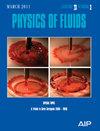Prediction model for self-starting of hypersonic inlets with soft critical unstart mode
IF 4.1
2区 工程技术
Q1 MECHANICS
引用次数: 0
Abstract
The acceleration self-starting performance of hypersonic inlets is of critical importance for the stable operation of scramjet engines. The occurrence of soft unstart during the transition from hard unstart to start is an important flow state that has yet to be fully elucidated. The stability mechanism and corresponding self-starting characteristics of soft unstart remain poorly understood, and there is a pressing need for detailed modeling research in this area. This paper presents a rapid prediction model for the self-starting Mach number of two-dimensional hypersonic inlets with soft critical unstart mode, fully considering the influence of various geometric parameters and Reynolds number in the internal contraction section, and achieving a quantitative analysis of the two-dimensional soft unstart critical flow field. Given the incoming flow conditions and the inlet geometry, the prediction model is capable of accurately representing the actual viscous unstart flow field. It can fully map the unstart separation bubble and its surrounding critical wave structures, and calculate the minimum pressure rise required to maintain the current scale of the main separation bubble and the pressure rise exerted on the unstart separation bubble by the current actual flow field structure. Comparing the relative magnitude of these two pressures determines whether the inlet can transition from soft unstart to start. The proposed prediction model was validated using results from unsteady numerical simulations. The predicted results align well with the simulation results and are significantly better than previous prediction methods.具有软临界非启动模式的高超音速进气口自启动预测模型
高超音速进气口的加速自启动性能对于涡喷发动机的稳定运行至关重要。在从硬非启动到启动的过渡过程中出现的软非启动是一种尚未完全阐明的重要流动状态。人们对软不起动的稳定机理和相应的自启动特性仍然知之甚少,因此迫切需要在这一领域开展详细的建模研究。本文提出了一种具有软临界非启动模式的二维高超声速进气道自启动马赫数快速预测模型,充分考虑了内收缩段各种几何参数和雷诺数的影响,实现了对二维软非启动临界流场的定量分析。在进气流场条件和入口几何条件允许的情况下,预测模型能够准确地反映实际的粘性非起动流场。它可以完整地映射出未起始分离气泡及其周围的临界波结构,并计算出维持当前主分离气泡规模所需的最小压力升高,以及当前实际流场结构对未起始分离气泡施加的压力升高。比较这两个压力的相对大小,就能确定入口是否能从软性未启动过渡到启动。利用非稳态数值模拟的结果对所提出的预测模型进行了验证。预测结果与模拟结果非常吻合,明显优于之前的预测方法。
本文章由计算机程序翻译,如有差异,请以英文原文为准。
求助全文
约1分钟内获得全文
求助全文
来源期刊

Physics of Fluids
物理-力学
CiteScore
6.50
自引率
41.30%
发文量
2063
审稿时长
2.6 months
期刊介绍:
Physics of Fluids (PoF) is a preeminent journal devoted to publishing original theoretical, computational, and experimental contributions to the understanding of the dynamics of gases, liquids, and complex or multiphase fluids. Topics published in PoF are diverse and reflect the most important subjects in fluid dynamics, including, but not limited to:
-Acoustics
-Aerospace and aeronautical flow
-Astrophysical flow
-Biofluid mechanics
-Cavitation and cavitating flows
-Combustion flows
-Complex fluids
-Compressible flow
-Computational fluid dynamics
-Contact lines
-Continuum mechanics
-Convection
-Cryogenic flow
-Droplets
-Electrical and magnetic effects in fluid flow
-Foam, bubble, and film mechanics
-Flow control
-Flow instability and transition
-Flow orientation and anisotropy
-Flows with other transport phenomena
-Flows with complex boundary conditions
-Flow visualization
-Fluid mechanics
-Fluid physical properties
-Fluid–structure interactions
-Free surface flows
-Geophysical flow
-Interfacial flow
-Knudsen flow
-Laminar flow
-Liquid crystals
-Mathematics of fluids
-Micro- and nanofluid mechanics
-Mixing
-Molecular theory
-Nanofluidics
-Particulate, multiphase, and granular flow
-Processing flows
-Relativistic fluid mechanics
-Rotating flows
-Shock wave phenomena
-Soft matter
-Stratified flows
-Supercritical fluids
-Superfluidity
-Thermodynamics of flow systems
-Transonic flow
-Turbulent flow
-Viscous and non-Newtonian flow
-Viscoelasticity
-Vortex dynamics
-Waves
 求助内容:
求助内容: 应助结果提醒方式:
应助结果提醒方式:


